ATTRACT POLLINATORS II HUMMINGBIRDS AND OTHER POLLINATORS Sugar water feeders provide food for hummingbirds (and summer bats) and we make them available every day of the year. However, one of the joys--and for many people goals--of gardening in the Southwest is attracting hummingbirds while beautifying their property. Since we moved to SE Arizona, at least 15 species of hummingbirds have occurred locally, 13 in our yard. Gardeners will find a surprising variety of small annuals and perennials, shrubs, vines, trees, and even potted plants that are available to attract hummingbirds. Many are low-water SW natives, or similarly drought tolerant plants from other regions. Our hummingbird spring begins with an assortment of Penstemons (beardtongues), Coral Honeysuckle, and Pomegranate, and continues with a variety of Salvias, Agastaches, Desert Willow, Ocotillo, Hummingbird Trumpet, and a few other odds and ends. Many of these also provide nectar for orioles, butterflies and native bees, and their seeds are eaten by Lesser Goldfinches. ii
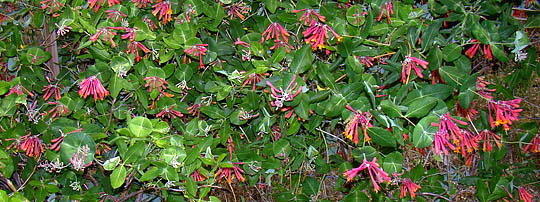 A native of the eastern U.S., Coral Honeysuckle (Lonicera sempervirens) is a valuable hummingbird attractant. It's a good choice for covering a section of fence if a visual screen is desired (18 April 2010). 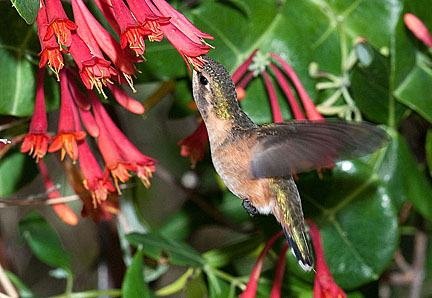
A female Lucifer Hummingbird feeds in Coral Honeysuckle blossoms (28 April 2010). 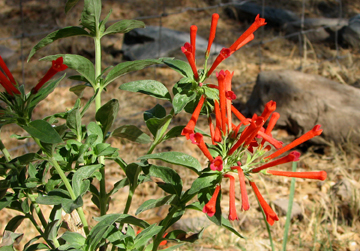
Firecrackerbush (Bouvardia ternifolia), is a member of the coffee family (Rubiaceae). It's a small, perennial shrub native to our canyons. Look at those red tubes! What more could a hummingbird want? (7 June 2006). 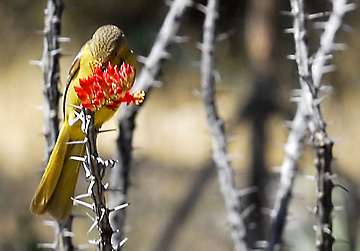
Prized for its architectural quality, Ocotillo is also an excellent source of nectar. Here a Scott's Oriole probes a cluster of buds before the leaves have developed (11 May 2007).
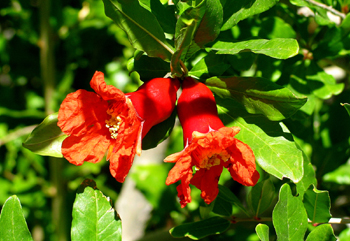
Pomegranate blossoms are a favorite of Broad-billed Hummingbirds (12 June 2004). , 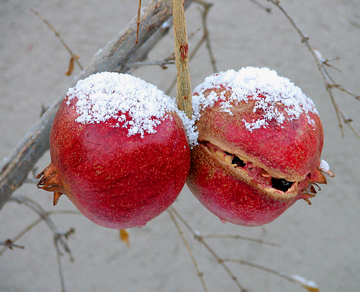
Later in the year, the Pomegranate's seeds are eaten by Verdins and various woodpeckers (20 December 2006). 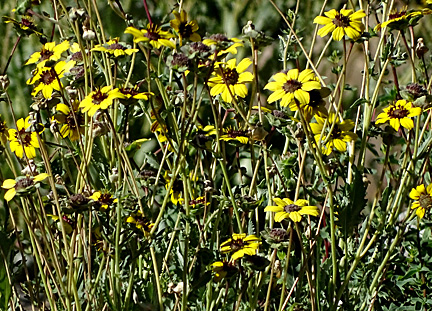
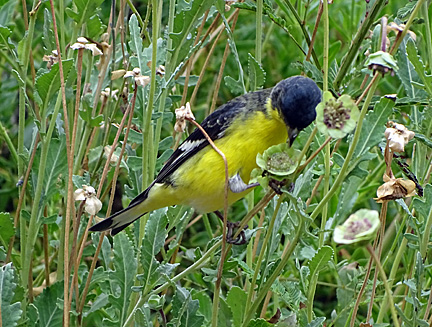
A local native composite, Chocolate flower, Berlandiera lyrata (two photos above), is a low water species that thrives in our yard - spreading freely with no encouragement. Its yellow blooms provide nectar for bees, flies, and butterflies, and its seeds nourish our Lesser Goldfinches (23 and 24 June 2016). Below, a Lupine Blue nectars on a Chocolate flower bloom (23 June 2016). 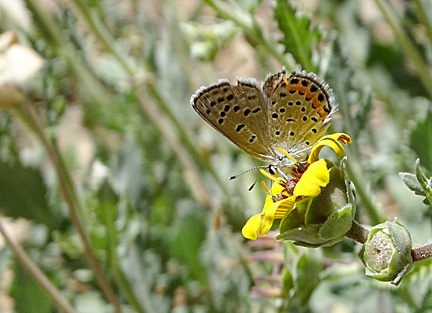
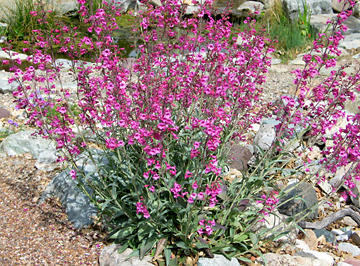
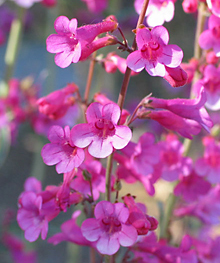
Parry's Penstemon or Parry's Beardtongue, Penstemon parryi, (two above) a local plant that does well in cultivation, requiring little care. It is used by many species of hummingbirds and a variety of insects (4 April 2007). 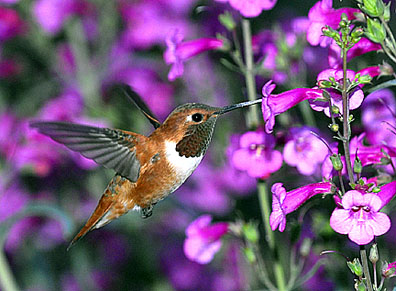
A male Rufous Hummingbird feeds in Parry's Penstemon (6 April 2007). 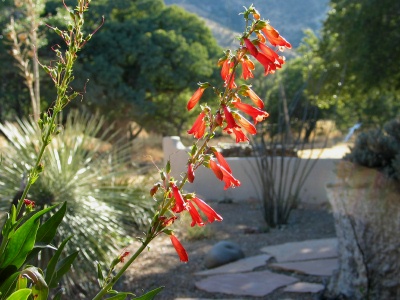
Firecracker Penstemon (Penstemon eatonii) provides early season nectar for several species of hummingbirds (16 February 2006). 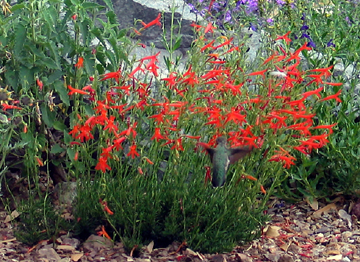
Blossoms of a Pineleaf Penstemon flutter in the breeze as a hummingbird feeds on them (19 May 2006 ) (Karen LeMay photo). 'Desert Sunrise,' a hybrid of Agastache cana and A. rupestris was, arguably, one of our most valuable plants for a variety of pollinators. A long-blooming perennial, it provided color, architectural quality, and loads of nectar for hummingbirds, butterflies, and bees. (7 August 2006). Eventually, this plant died and we miss its presence. If anyone sees this variety for sale, please drop me a note. l/ 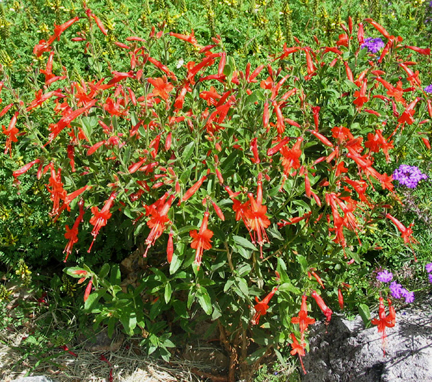
Hummingbird Trumpet (Zauschneria arizonica) (above and below) is another fine hummingbird and butterfly plant with bright orange-red tubular blossoms (20 September 2006). 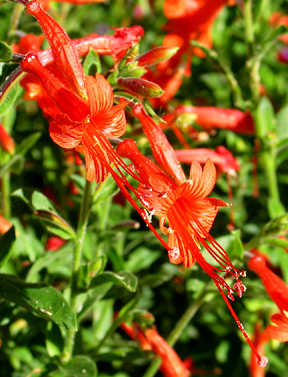
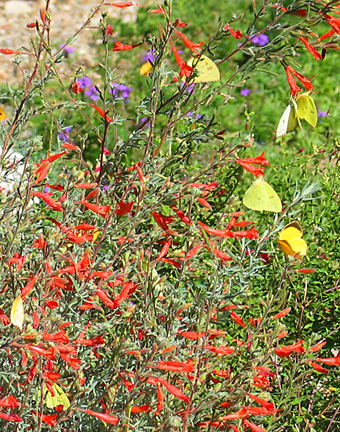
On 11 October 2006, this Zauschneria californica latifolia hosted more than 25 Cloudless Sulphurs, Southern Dogfaces, and Tailed Oranges.
MORE PLANTS FOR BEES, BUTTERFLIES, AND OTHER POLLINATORS;; ;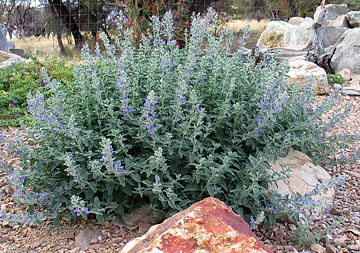 ; ; Catmint (Nepeta) uses little water and attracts large numbers of blues, skippers, bee flies and other pollinators. Whack it back during winter and whenever it looks bloomed out and brown and it will reward you with dense, new growth (Karen LeMay photo: 10 April 2006). //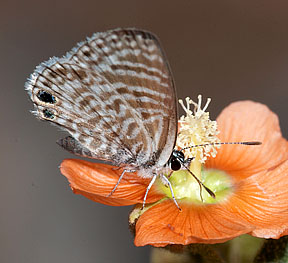 / / /
A common roadside plant, Globe Mallow (Sphaeralcea) isn't often considered worthy of cultivation. However, it thrives with little to no care, has numerous small but attractive blooms of yellow, orange, red, white, or lavender, and serves as host plant for several species of butterflies. Here, a Marine Blue nectars on a blossom (top) (5 May 2010), a small sweat bee (Agapostemon obliquus) gathers pollen from another (L) (6 May 2010), and a syrphid fly (Eupeodes volucris) (R) feeds on a third (5 May 2010). 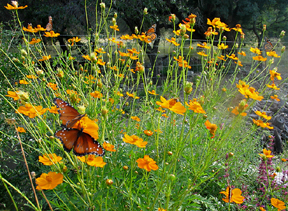 ; ;
Growing to at least five feet in height, this form of Cosmos provides a mass of colorful flowers and is useful for filling gaps in the garden. Cosmos is a great butterfly attractant; note the two Queens feeding in the foreground (Karen LeMay photo) (26 September 2005). 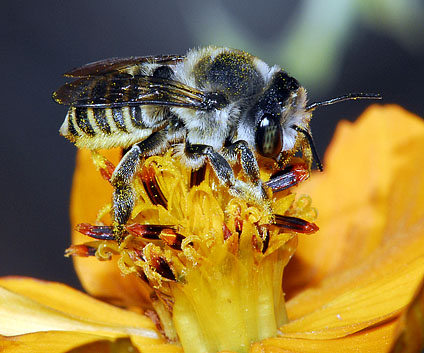 ; ;
In our yard, leaf-cutter bees (Megachile) aren't numerous enough to damage the plants. Here one gathers pollen at a Cosmos blossom (2 November 2006). 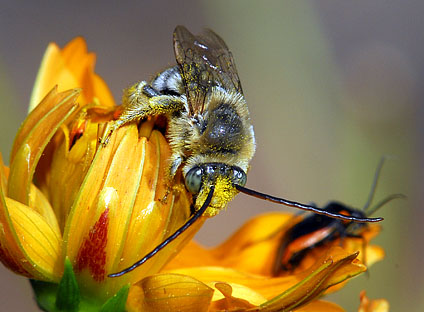
Another Cosmos provides pollen for a long-horned bee (Melissodes) a member of the family Apidae that includes the honey bees and bumble bees (10 October 2006).
,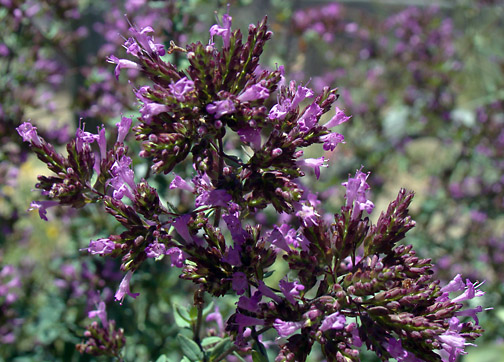
Ornamental oregano (Origanum) forms a spreading, evergreen clump that can, after two or three years, be divided to share with friends. It grows in full sun (above 8 July 2009). The shot below shows several dozen Lyside Sulphurs nectaring on this plant (9 July 2009). 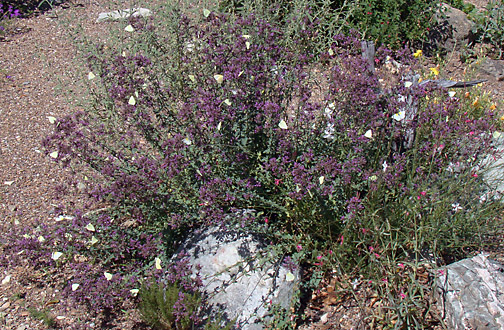
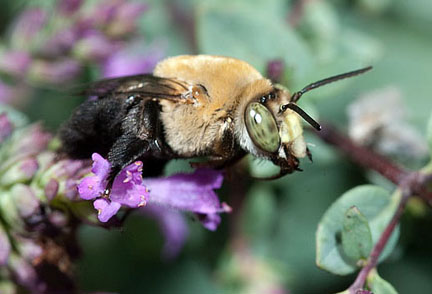
Several of the bumblebee relative Centris atripes were present nectaring on oregano (29 July 2010). 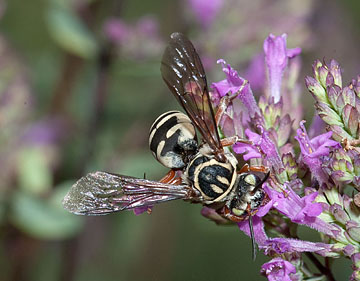
Another insect that nectars on oregano is this cuckoo bee (Triepeolus grandis). Like the bird it's named after, these bees are nest parasites, laying their eggs in the nests of other bees (25 July 2010). 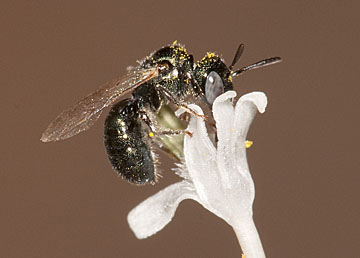
Related to the huge Carpenter Bees but only several millimeters long, this Ceratina bee forages in the early blossoms of Guardiola (14 Febuary 2014). 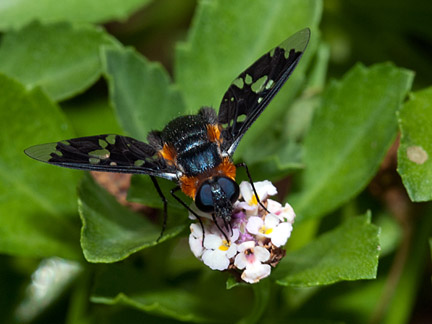
Bee flies are important pollinators in the garden and we have seen perhaps 40 or 50 species in the yard. Here, Exoprosopa rhea, one of the most attractive species, feeds on frog fruit (11 September 2011).
, 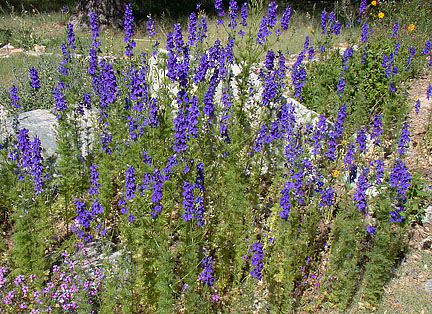
Larkspur (Delphinium sp.) is an "English Cottage Garden" plant we tolerate in the yard. Every spring it comes back on its own and, with the addition of almost no water, provides a tall swath of color and cut flowers for the house. After it sets seed (some of which we gather), we pull it out to make room for other plants. An occasional hummingbird nectars at it as well as a few carpenter and bumble bees (14 May 2010). 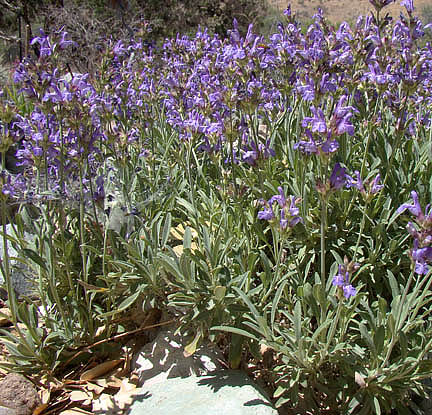
,
Culinary Sage (Salvia officinalis) is native to the Mediterranean region. This plant remained evergreen through a winter with four degree nights. Besides supplying leaves for cooking, it massive floral display provides nectar for bees and other pollinators (26 April 2011). , 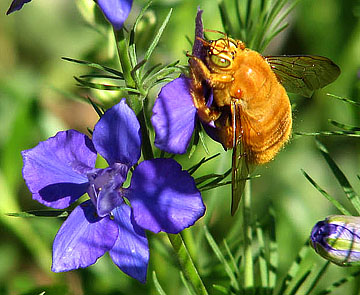
. A male Valley Carpenter Bee (Xylocopa varipuncta) nectars at Larkspur (27 April 2008) (Karen LeMay photo). m 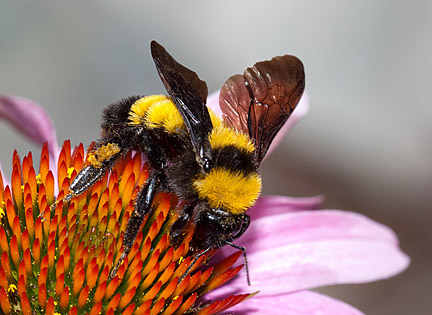
The Bumblebee Bombus sonorus is a colorful addition to the yard and can pollinate during cooler weather. Three females were on these coneflower blossoms when the photo was taken (6 July 2010). 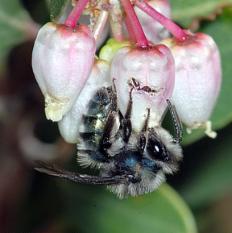 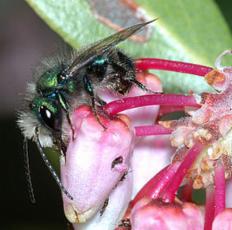
Pointleaf Manzanita (Arctostaphylos pungens) is a common shrub in the mountains of SE Arizona. It's an attractive landscaping plant that thrives with the addition of winter water. Flowering early in the year, it provides nectar for insects such as the mining bee Andrena cerasifolii (L) (19 February 2010) and the mason bee Osmia ribifloris (R) (14 February 2010). 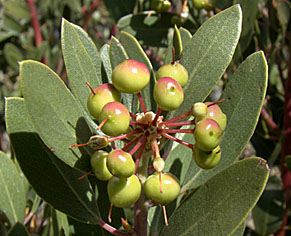
Once pollinated, Manzanita blossoms produce berries that are eaten by wildlife including Coyote, Gray Fox, Black Bear, and a variety of birds (2 April 2010) 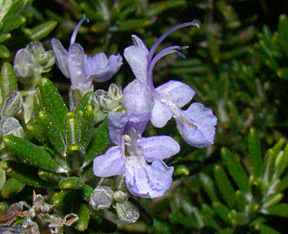
Tiny Rosemary flowers (Rosmarinus officinalis) provide precious winter nectar for honey bees and hardy butterflies such as checkered-skippers and Dainty Sulphur (18 Jan 2009). 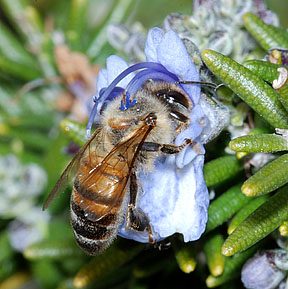
The fuzzy back of a honey bee is targeted by both the pistils and anthers of a rosemary flower (16 February 2010). 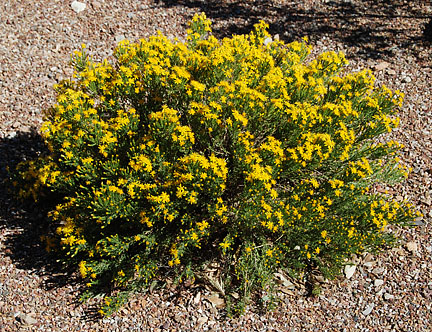
Turpentine Bush (Ericameria laricifolia) is a low water, no care, evergreen bush found from Texas to California. It volunteers in the yard so we always have a few of different sizes. Although not as effective a butterfly attractant as the closely related Rabbitbrush, it does draw in a number of insects (15 October 2007) A favorite of butterfly gardeners, Lantana thrives on little water, providing a massive and months-long bloom. In other parts of the world it's a noxious, invasive weed but not here. At our elevation, it dies to ground level each winter but explodes back to life each spring. Many of the yard's best butterflies have been found as they fed on Lantana (23 June 2010). 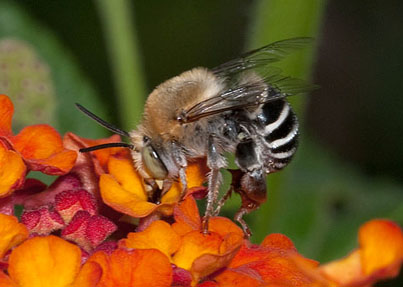
A digger bee Anthophora californica feeds on lantana (27 July 2010). 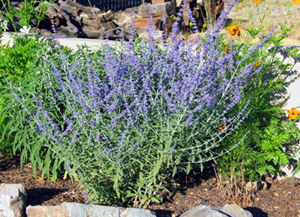
Russian Sage (Perovskia) is large, showy, and provides food for many species of butterflies, as well as native bees and wasps (7 June 2006). 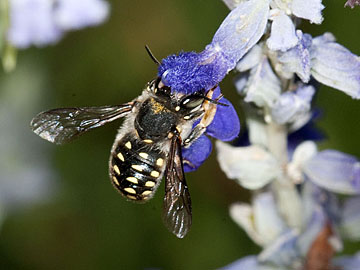 Nectaring on Russian sage was this very pretty carder bee (Anthidium maculosum), whose common name is derived from the female's behavior of lining her nest burrow with wooly plant fibers (27 July 2010). 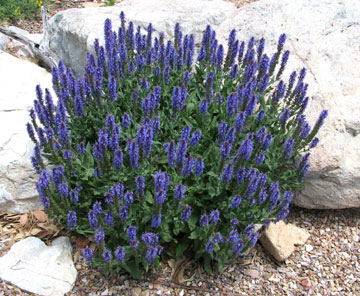
Salvia nemerosa is native to central Europe and western Asia. It is available in a number of short and tall cultivars which are generally dark blue or purple. At our elevation it dies to ground level, reappearing in spring. It attracts many species of butterflies (7 May 2007). 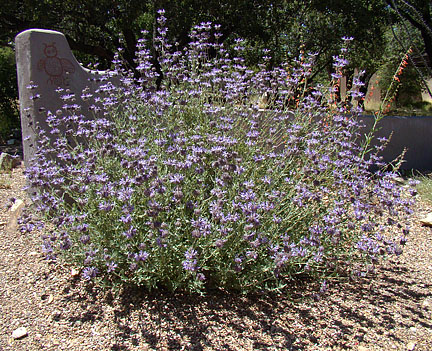
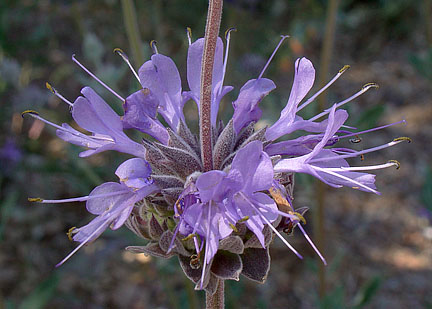
Several Salvias native to California's brushy (chaparral) covered slopes form large shrubs. One commonly encountered species is Cleveland Sage (Salvia clevelandii) (two photos above), an extremely aromatic species that reaches a height and width of five to six feet. Drought tolerant and able to grow in sand and on rocky slopes, Cleveland Sage attracts butterflies, sphinx moths and hummingbirds. Give it enough room to spread and whack it down to 1/3 its height in winter (24 May 2010). 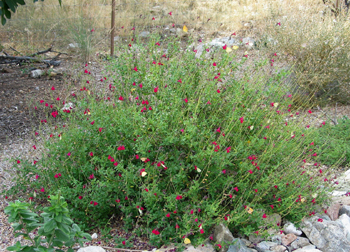
Two Salvias that attract hummingbirds and hordes of butterflies are S. serpyllifolia (8 November 2005) (above) and S. grahami (8 November 2005) (below). In these pictures, dozens of Mexican Yellows and Sleepy Oranges are nectaring on each, as well as smaller numbers of Tailed Oranges and Gulf Fritillaries. Both produce more blooms with pruning and an occasional sip of water. 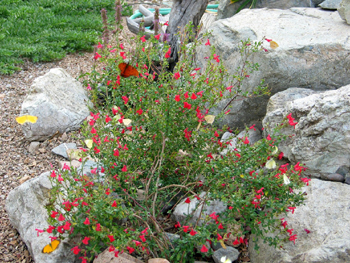
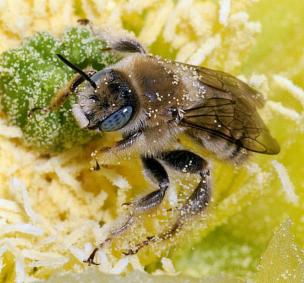
Cactus bees (Diadasia), also related to honey and bumble bees, pollinate the prickly pear and cholla cacti that are so numerous in the Southwest (13 May 2010). 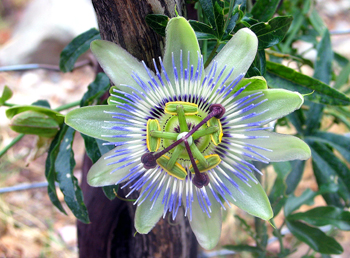
Passion flowers (upper photo) are one of the strangest sights in the plant world. The hardy Passiflora caerulea is evergreen at 5,000 feet. It may be stripped by caterpillars of the Gulf Fritillary but leafs out again very quickly. It uses almost no water and creates dense vines that can serve as a visual screen if desired (16 May 2010). Carpenter bees (Xylocopa), along with queen bumble bees, are our largest bees. Here, one feeds in a passion flower, pollinating it by making contact with both pistils and anthers (1 August 2006).
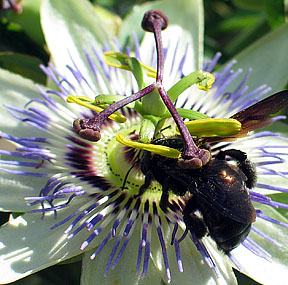
For additional information on butterflies, moths, reptiles and amphibians, wildlife gardening, native plants, xeriscape gardening, plant sales, and water harvesting in SE Arizona, please visit the following sites: On line Field Guide to the Reptiles and Amphibians of Arizona SEABA (Southeastern Arizona Butterfly Association) Butterflies and Moths of North America The Arizona Native Plant Society - now with a Cochise Chapter Desert Survivors - An important plant source in Tucson Tohono Chul Park - Education, birdwatching, and great plant sales Arizona Sonora Desert Museum - Education, birdwatching, and great plant sales High Country Gardens (On line plant catalog) Tucson Botanical Gardens - Education, birdwatching, and plant sales Oasis Water Harvesting - Rain barrels, pumps, water collection design, etc. WaterWise: University of Arizona Cooperative Extension, Cochise County Arizona Master Gardener Manual (On line edition)
© Robert A. Behrstock 2021
Images may not be reproduced without the Photographer's permission. 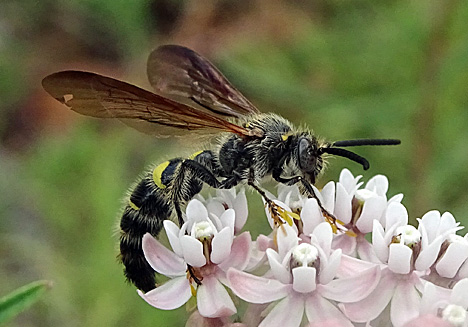
| A scarab-eating wasp (Campsomeris) on Arizona Milkweed (18 July 2017). Note below the milkweed's yellow pollen sacs (pollinia) adhering to the legs of the wasp. Not only is the wasp pollinating the milkweed, but it lays its eggs on destructive beetle larvae found in lawns and gardens. | 
|
|